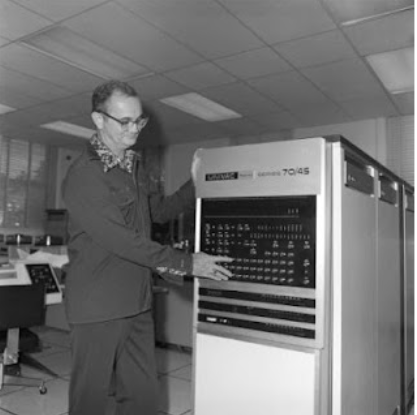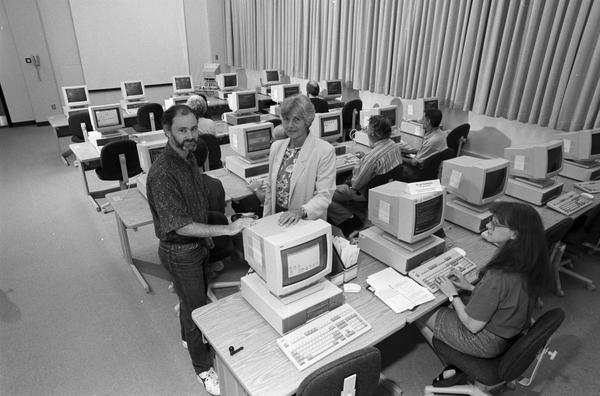Computers seem ubiquitous on the UNCG campus today, that hasn’t always been the case. While a campus network of computers wasn’t in place until the 1990s, faculty and staff have made use of computers and computing services offered on campus since 1959.
In 1959, the Consolidated University of North Carolina opened its first computation center in Chapel Hill. This center was intended to serve faculty from all three Consolidated University campuses — UNC, N.C. State, and Woman’s College (now UNCG). On November 19, a six-week seminar for interested WC faculty and staff began. This seminar aimed to “provide training and experience which will enable each of us to determine the applicability of the computer for our own areas of interest, and to adapt our research problems to the machine.”
In 1967, UNCG opened its own administrative computer center in the Petty Science Building. This computer center, headed by Dr. Roscoe Allen, former head of the commercial department, was primarily used to computerize the university’s personnel records, as required by the federal government as part of an ongoing civil rights litigation.
That same year, the University also gained a teletype connection to a computer based at the Triangle Universities Computation Center (TUCC) in Research Triangle Park. This terminal, located in the Forney Building, allowed faculty and students to run programs (but at least half of the connection’s allotted time was dedicated to sponsored faculty research). All data that was to be processed had to go through and be submitted by the designated Supervisor of the Terminal.
 |
| Campus computing, 1975 |
As demand for computer access grew, campus computing was divided into two separate offices in 1973 — one focused on administrative computing and one on academic computing. Additionally, computer center staff began offering workshops to faculty, staff, and students. These workshops, meant to introduce the UNCG community to “the computing facilities and services and the various program and languages available,” included sessions on statistical packages like SPSS as well as programming languages like FORTRAN.
By 1976, there were at least 13 academic computer terminals across campus allowing faculty, staff, and students to connect to the TUCC, but that fell far short of demand. Computer access had to be rationed until 1981 when UNCG acquired its first on-campus academic computer — a new VAX machine installed in the new business and economics building. Although many faculty continued to dial in via remote access to the TUCC, the new VAX was quickly flooded with faculty and student users. Long waits, limited use time, and emergency deletion of files caused troubles for all campus computer users.
Some relief came in the early 1980s with the growing popularity of personal computers (then known as microcomputers). Several UNCG departments financed small microcomputer labs of their own, but, aside from the high cost of the machines themselves, many departments lacked the money and expertise to properly maintain and service the computers.
Finally, in 1990, the administrative and academic computer centers were merged. Computers were upgraded, and new labs were added across campus. By 1993, most academic buildings were connected to the campus network, and soon after the network began to reach dormitories as well.
By Erin Lawrimore

